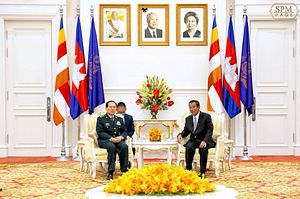By Prashanth Parameswaran
 On February 4, an Australian media outlet revealed new evidence of a previously undisclosed military visit between China and Cambodia that spotlighted defense links between them in areas such as military facilities and satellite navigation. The report shed light on some of the more secret components of China-Cambodia defense interactions and intensified the scrutiny on the two countries for the continued lack of transparency in security activities they are carrying out despite the wider regional implications they could have.
On February 4, an Australian media outlet revealed new evidence of a previously undisclosed military visit between China and Cambodia that spotlighted defense links between them in areas such as military facilities and satellite navigation. The report shed light on some of the more secret components of China-Cambodia defense interactions and intensified the scrutiny on the two countries for the continued lack of transparency in security activities they are carrying out despite the wider regional implications they could have.
As I have noted before in these pages, the idea of a deepening Chinese security presence is not new, with China long being a key defense partner for Hun Sen’s Cambodia, including its top provider of military equipment. But over the past few years, China’s military links to Cambodia have been under increased scrutiny amid wider trends and developments, including Beijing’s cultivation of broader security partnerships in the region as well as evidence of specific manifestations of China-Cambodia defense ties such as access to Ream naval base, which would have wider geopolitical implications.
This week, we saw another instance that deepened concerns regarding Chinese military facilities in Cambodia. A document obtained by the Australian Broadcasting Corporation (ABC) revealed a previously undisclosed Chinese military visit to Cambodia in late December 2019 and its potential significance for ongoing China-Cambodia defense cooperation.
The document, obtained by ABC from an anonymous source, discloses the schedule of a six-member Military Surveying and Mapping delegation headed by Major General Song Ming Wu, the deputy rector of the Information Engineering University of PLA, from December 20 to 24. The schedule reportedly included visits to “investigate Ream base” as well as other locations, including Koh Takiev – home to a small Cambodian naval outpost – and Koh Poulu Wai; a meeting with 20 Cambodian troops who recently completed a six-month “surveying, mapping and navigation training class” in China; and a look at a “satellite navigation and positioning reference station” in Siam Reap province. Beyond that, ABC also said that this raised concerns about recent developments in Cambodia, including questions as to whether the reportedly accidental landing of a military-grade Chinese-made drone in a field in southern Cambodia that occurred in January was tied to aspects of technology training between Cambodia and China.
The revelation of the visit is itself not surprising when viewed in the broader context of the rising military links between China and Cambodia we have witnessed over the past few years. But it is not without significance. Like some previous instances, it has shed the light on some of the more secret components of China-Cambodia defense interactions, as we have seen with past reports on aspects such as deliveries of military equipment and exchanges. And more broadly, it further intensifies scrutiny on Cambodia and China for the continued lack of transparency in security activities they are carrying out, which have implications for the region that extend beyond the two countries, whether it be threat perceptions and the balance of power in mainland Southeast Asia or in the evolving context of growing U.S.-China competition.
To be sure, we have yet to see more details and specifics surface on these developments, including responses from China and Cambodia and subsequent follow up reporting on the links between the visit and developments such as revelations on military facilities and the recent drone discovery. But more generally, this report and ones like it only add to the growing evidence of China’s deepening military links with Cambodia and the continued scrutiny on it, irrespective of whether the two countries change how they manage this aspect of the bilateral relationship.
No comments:
Post a Comment